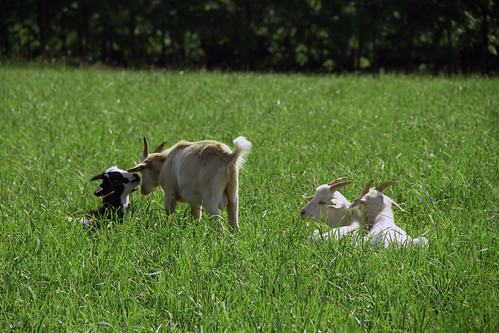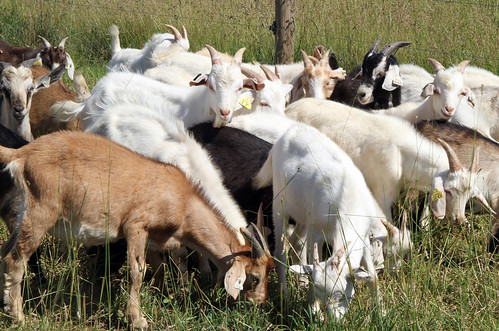The Western Maryland Pasture-Based Meat Goat Performance Test was
initiated at the University of Maryland’s Western Maryland Research
& Education in Keedysville (Washington County) in 2006.
The purpose of the test was to evaluate the post-weaning performance of meat goat bucklings consuming a pasture-based diet, with natural exposure to internal parasites. Identifying bucks that were resistant and resilient to internal parasites was the trademark of the test.
The test was conducted for eleven years. Almost 800 bucks were evaluated. While the test was open to any breed or cross of goat, it gradually evolved into a “Kiko test.” Over the span of the test, more than 100 producers from 20 states consigned bucks. Top-performing bucks were sold (as far away as California) or returned to farms for breeding.
Over
the years, many
programs and activities were held in conjunction with the test,
including field days, tours, sales, skillathons, and carcass evaluation.
In 2014, the BluegrassPerformance Invitational in Frankfort, Kentucky, was established as a place to
sell performance tested goats, including the top-performing bucks from the Maryland test. This year's sale is September 1-2, 2017.
Now, the goat test era is over (in Maryland). Goat producers will be encouraged and assisted in their move to the next step in performance testing: within and across-herd EBVs. EBV stands for estimated breeding value and is a measure of genetic merit, The data is far more accurate than the data from buck tests.
A sheep research program will be initiated at the Western Maryland Research & Education next spring (2018). The pastures are being re-established and new infrastructure is being put in, as the hoop house that was installed several years ago was completely destroyed this past winter.
Internal parasites (GI worms) will likely continue to be the focus of the research program, as it is a logical follow-up to the goat test and parasites remain a major obstacle to profitable small ruminant production. We also plan to plant different forages for grazing.
I’d
like to express appreciation to my “Goat Team”: Jeff Semler, David
Gordon, Pam Thomas, and Mary Beth Bennett. Others who played key roles
include E. Nelson Escobar, Niki Whitley, Willie Lantz, Chris Anderson,
Jeanne Deitz-Band, Lexie Simmons, and Amy Garza.
Dr. Dahlia O’Brien at Virginia State University (previously at Delaware State University) was instrumental to the success of the test, as she performed all the fecal egg analyses.
Thanks to the Maryland Grain Producers Utilization Board for providing funding for the pen vs. pasture studies.
Thanks to everyone who supported the goat test over the years, including all the consigners and buyers of bucks.
Susan Schoenian
Sheep & Goat Specialist
University of Maryland Extension
The purpose of the test was to evaluate the post-weaning performance of meat goat bucklings consuming a pasture-based diet, with natural exposure to internal parasites. Identifying bucks that were resistant and resilient to internal parasites was the trademark of the test.
The test was conducted for eleven years. Almost 800 bucks were evaluated. While the test was open to any breed or cross of goat, it gradually evolved into a “Kiko test.” Over the span of the test, more than 100 producers from 20 states consigned bucks. Top-performing bucks were sold (as far away as California) or returned to farms for breeding.
 |
| Bucks from the 2012 test |
Now, the goat test era is over (in Maryland). Goat producers will be encouraged and assisted in their move to the next step in performance testing: within and across-herd EBVs. EBV stands for estimated breeding value and is a measure of genetic merit, The data is far more accurate than the data from buck tests.
A sheep research program will be initiated at the Western Maryland Research & Education next spring (2018). The pastures are being re-established and new infrastructure is being put in, as the hoop house that was installed several years ago was completely destroyed this past winter.
Internal parasites (GI worms) will likely continue to be the focus of the research program, as it is a logical follow-up to the goat test and parasites remain a major obstacle to profitable small ruminant production. We also plan to plant different forages for grazing.
 |
| Bucks from the 2014 test |
Dr. Dahlia O’Brien at Virginia State University (previously at Delaware State University) was instrumental to the success of the test, as she performed all the fecal egg analyses.
Thanks to the Maryland Grain Producers Utilization Board for providing funding for the pen vs. pasture studies.
Thanks to everyone who supported the goat test over the years, including all the consigners and buyers of bucks.
Susan Schoenian
Sheep & Goat Specialist
University of Maryland Extension

No comments:
Post a Comment